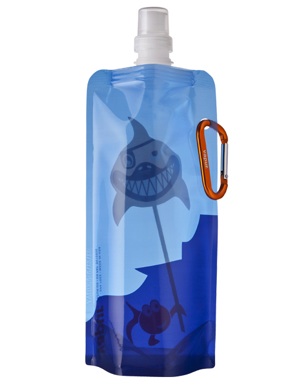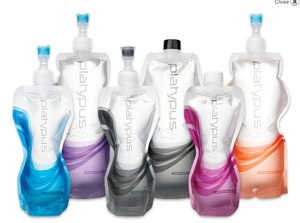With warm weather already here in some parts of the Southwest, and with disposable water bottles on their way out from a number of national parks, what's the best way to stay hydrated in the parks?
That's an easy question to answer: either resort to a hydration bladder in your pack, or invest in a reuseable water bottle or two.
How best to carry tap water with you gained more than a little attention earlier this year courtesy of the move to ban the sale of disposable water bottles at Grand Canyon National Park. Zion and Hawaii Volcanoes national parks already had headed down that path, and Canyonlands and Arches national parks in Utah are said to be going that way, too.
Why the ban? It's a bid to reduce waste. At Grand Canyon, officials believe the ban will eliminate the source of 20 percent of the park's "waste stream" and 30 percent of its recyclables.
Of course, the ban is only on the "sale" of disposable water bottles. You won't be fined for bringing your own disposable water bottle into the park, or using your soda bottle to carry water. Still, in the name of reducing waste and encouraging sustainability, this is a step in the right direction.
What will this cost you? Pricing for reusable bottles runs the gamut, from less than $3.50 at the visitor center in Zion National Park all the way upwards of $25 for a 700-milliliter insulated, stainless steel bottle from MiiR that is said to keep "cold things cold" for 24 hours, something that'd be appreciated when you reach Phantom Ranch at the floor of Grand Canyon and the temperature is 120 degrees.
The market offers quite a few bottling options, in steel, hard plastic, and soft plastic. There are plastic hydration bladders you stuff into your pack, soft plastic bottles you can also stuff into your pack or, in the case of Vapur, clip onto your belt or pack with the integrated carabiner clip. And, of course, there are the hard plastic bottles, such as Nalgene bottles, that you can slip into your pack as well.
Where you put your money depends on whether your focus is simply on day hiking, or if you plan on extended backpacking treks. Obviously, the more need you see for carrying water might encourage a more significant investment in bottling.
And where you'll be carrying that vessel is something to consider, too. Overnighting in the backcountry and planning to relax around a campfire? Stainless steel bottles won't melt if a wayward cinder lands on them...but they are heavier.
Here's a look at some of the choices out there:
* Vapur
Dubbed by its creators as "the anti-bottle," the brand new Element soft plastic container ($11.99 for a .7-liter model, $13.99 for a liter) is a competitor to the Softbottle from Platypus.
Selling points for Vapur: On some models there's an integrated clip on the side that you can afix to your belt or a loop on your pack. The Element, expected to be available in late March, has the clip integrated into the cap. When empty the 'bottle' can be folded or rolled up and stuffed out of the way; it's dishwaster safe; you can freeze it and use it either as an ice pack or to enjoy ice-cold water on your way down the South Kaibab Trail at the Grand Canyon; no BPA, and; the 3-ply nylon-poleythelene layering has anti-microbial inhibitors. Vapur has several other options in its line, including the "Artist Series" that offers bold designs.

One of the designs from Vapur's Artist Series.
Potential low points: The carabiner clip is made from plastic, so durability could be an issue; the flip-top cap on the Element requires, unless you're incredibly dexturous, two hands to open, and then you face a hard-plastic spout. You can, however, purchase additional caps, including one version that features a push-pull spout; cleaning might be an issue; could be difficult to fill out in the field if you use a water filter.
As noted, you can put this into your dishwasher, inverted over two prongs, but will this ensure cleaning to the bottom of the bottle? And then there's the drying time: you invert the bottle on the counter and let gravity and airflow do the job. (I've gotten around this with similar containers by using my ski-boot drier...) Finally, no insulating ability.
* Platypus
An arm of Cascade Designs, the Platypus makes a range of soft plastic bottles, from the aptly named Softbottles ($7.95-$11.95 for half-liter version, depending on cap) to the plusBottle, ($16.95) a one-liter vessel. In short, they are similar in theory to the Vapur products: a soft plastic container with a push-pull spout on the top.
Selling points for Platypus: No BPA went into their construction; proprietary "Slimeguard" also lends anti-microbial benefits for the plusBottle, which also has an integrated "hang loop" for affixing to your pack.

Softbottles from Platypus.
A big brother to the Softbottle, though not quite as soft, pliable, and durable as the plusBottle, is the Platy Bottle ($12.95), which carries 2 liters. You can customize your Softbottle with a variety of drinking spouts. (The 1-liter plusBottle is pricier than the Platy Bottle due to its Slimeguard and slightly more pliable plastic.)
All of these "bottles" can withstand boiling and freezing (just be sure to leave a little space for expansion when freezing).
Potential low points: Similar to those for Vapur when it comes to cleaning, drying, refilling in the field, melting if you get it too close to hot embers. Also not insulating.
* MiiR
Cast from BPA-free, 18/8 stainless steel, these canisters pack a bit more heft than the soft plastic competitors, weighing in at 27 ounces for an 800 ml version.
Selling points for MiiR: Go with an insulated model ($23 for a 500-ml model, $25 for 700 ml) and you can keep hot beverages hot for up to eight hours, and cold beverages cold for up to 24 hours. Don't care about insulating your drink? The 600 ml uninsulated version retails for $18.

MiiR's various 'skins' will add some dazzle to your pack.
These definitely will be more durable than a soft plastic vessel. Plus, the wider mouth opening -- 1.4 inches across -- funnels more water into your mouth more quickly than some of the competition. The caps also are designed with fewer threads so it only takes one revolution to open/close. And steel won't absorb flavors. These bottles come in a range of sizes, so you likely can zero in on the one that fits best in your pack.
MiiR also has a program through which $1 of your bottle's purchase goes to provide clean water for one person for one year.
Potential low points: While more durable than soft plastic, these are also bulkier and weigh more. While some models are top-rack safe for dishwashers, the company recommends hand-washing.
These folks have been making 18/8 stainless steel, BPA-free bottles since 2004. In their catalog is a wide array of bottles (MSRP $14.95-$32.95), from 5-ounce baby bottles complete with nipples to wide-mouth 64-ounce containers that you can screw some water filters right onto for easy filling in the field.
Selling points for Klean Kanteen: Self-described as the pioneer in stainless steel drinking bottles, these folks have a nice variety of vessels -- 12-ounce, 18-ounce, 27-ounce, 40-ounce, even all the way up to 64-ounce, a size you best have a canoe, kayak, or vehicle to carry it in.
Even better, their "Wide" series has an opening wide enough and with threads that will accommodate most backcountry water filters without the need for a special adapter. They make insulated models, as well. Also, stainless steel is not known for absorbing flavors from their contents.
The folks at Klean Kanteen dedicate 1 percent of their gross annual sales to the 1% For the Planet program that helps support non-profit programs such as the Breast Cancer Fund, the Buffalo Field Campaign, and NatureBridge.
Potential low points: Well, for starters, these bottles are heavier than their plastic brethren. And they're not pliable for squeezing into a pack. Though pricier than plastic competitors...they'll also last longer.
Both the MiiR and Klean Kanteen bottles also allow some sort of personalization of your bottles through the use of "skins," so no need to be in the backcountry confused over which stainless steel bottle has your germs on it.
Getting That Water Safe To Drink
It has been beaten into backcountry wanderers: Don't drink untreated water, as you don't know what lurks within.
So what do you do? Water filters are preferred by many. There are pump filters, such as MSR's Waterworks, a model I've used for the past decade, and the more recent sterilizing wands, such as those made by SteriPEN. And the folks at Camelbak have even come out with a bottle that has a UV-emitting cap to kill whatever nasties you might scoop up while aiming to quench your thirst, though with an MSRP of $99 that might be a bit much for many.
In his gear book, The Ultimate Hiker's Gear Guide, Andrew Skurka is a fan of chlorine dioxide purifiers, such as Aquamira drops, which kill most any bugs you might scoop up. While this concoction must be mixed up five minutes before dumping it into your water bottle, the drops are much lighter to carry than a water filter.
However, you have to wait 15-30 minutes to kill giardia, and up to four hours to wipe out Cryptosporidium, says Mr. Skurka. As a result, a backup such as the SteriPEN is a good addition to your pack that uses UV rays to kill everything, including Cryptosporidium.
And while Mr. Skurka prefers stainless steel or hard-plastic bottles, there is one benefit to a soft-plastic bottle: They can double as pillows, he tells us in his book. "Fill the bottles three-quarters full with air and water, and then put them inside a stuff sack with some extra clothing," he writes.
Brilliant!


 Support Essential Coverage of Essential Places
Support Essential Coverage of Essential Places







Comments
With all due respect to Mr. Skurka, according to the CDC, "(d)isinfection with chlorine dioxide has a low to moderate effectiveness in killing Cryptosporidium." The incubation period can be as short as two days, so I suppose you can risk it if you're going to be done with your trip by then, and if you're otherwise healthy. I'd prefer not to though, and don't mind toting my 11 ounce MSR filter with me.
The CDC has more info on their page "A Guide to Drinking Water Treatment and Sanitation for Backcountry and Travel Use" at http://www.cdc.gov/healthywater/drinking/travel/backcountry_water_treatment.html.